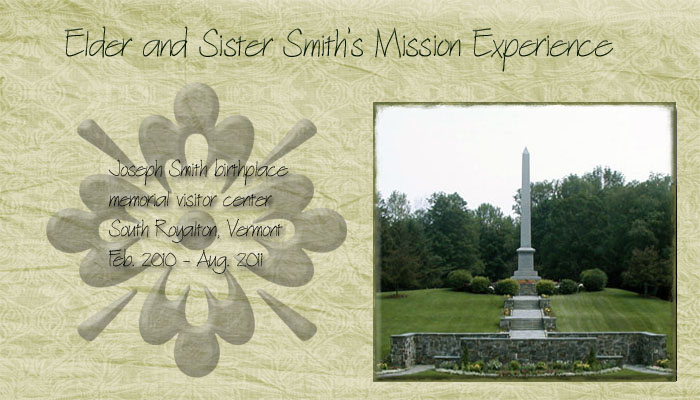
History of the Joseph Smith Birthplace Memorial.
Joseph Smith was born Dec 23rd 1805, in Sharon Vermont. Solomon Mack the father of Lucy Mack Smith bought the farm at the age of 72 hoping his children would gather close and farm the land with their families. Joseph Smith Sr and Lucy Mack Smith leased 68 acres in the early spring of 1805 and farmed in the summers and Joseph Sr taught school in the winters. It is in this home that Joseph Smith Jr. was born (Dec 23rd 1805) The footings for the Solomon Mack home are still on the grounds, unfortunately the footings for the home in which the Prophet was born are gone. (the prior visitors center and mission home built in 1905, were built on the exact spot of the birth home). Our site has two original artifacts, a Hearthstone and the Doorstep both found in the cellar hole of the 1805 birth home, and used in the cottage built on site in 1905. The church replaced the cottage with a new visitors center in the mid 1960's and moved the hearthstone from the old, to the new center, and left the doorstep on the birth site. The new visitors center was moved several hundred feet south of the birth site. I always have such a reverent feeling when I stand close to the hearthstone and think of Joseph as a young boy being nurtured by his parents close to this stone, and to the warmth of the fire.
The family moved several times and were living in West Lemanon, New Hamshire (about 15 miles from Sharon Vermont), when Joseph Smith Jr. had his well known leg surgery.
Just after the turn of the century Junius F Wells a history buff and the son of Daniel H Wells (a councilor to the Prophet Joseph F. Smith) came to Vermont to try and locate the prophets birth site. After much work on his part to document the 100 acre farm Solomon had once owned, he presented the idea to the First Presidency that a monument be build to commemorate the 100th year of the birth of the Prophet Joseph Smith . His idea was readily accepted and he then was given instructions to buy the land, design a monument, arrange for and supervise the construction there-of, and oversee the dedicatory ceremony. The purchase was made in the spring of 1905 which left little time to complete the monument project. He designed a monument that would testify to all who came of the life and sacrifices of the prophet Joseph Smith Jr. The shaft is 38 1/2 feet tall (representing one foot in height for every year of the Prophets life). The shaft weighs 40 tons and is one of the world's largest single pieces of flawless polished granite, the base is made of 4 pieces and weighs more that 60 tons. At the time the granite came out of the quarry the shaft weighed 60 ton.
In 1905 there were no large trucks or cranes for the lifting and moving of these massive pieces of granite. It came from a quarry in Barre (Berry) Vermont about 35 miles from the monument site. It came by rail the first 30 miles to Royalton Vt. That left more than 5 miles of curving, steep, dirt roads. A special wagon was built with 20" wide wheels to transport the granite the last 5+ miles. The road at the time of the move was so muddy that it required planks ( 8-10") to be placed under the wheels. As the wagon moved over the planks the men would pick them up from the back and replace them at the front. It took 33 days to make the move from Royalton to the monument site. It took 22 horses and several teams of oxen to make the move, and they also used block and tackle as an additional pulling method the last 2 1/2 miles which destroyed most of the large maple along dairy hill road. used. At one point they came upon a mud hole (Mr Button's Mud hole) they felt they could never cross. At the time they approached the hole a hay wagon was stuck in the mud up to its wagon bottom. Junius asked his men if they believed in faith, "lets all go home and get a good nights rest and things will be better in the morning" during the night the weather changed and the temperature dropped more than 30 degrees in some three hours, that allowed them to cross the mud hole in safety and without a loss of any time.










